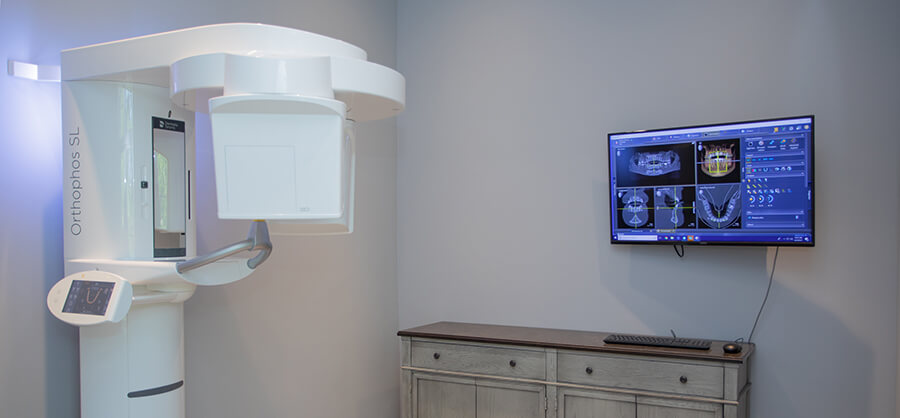General Dentistry
 Routine dental exams are the cornerstone of your oral health. While your daily brushing and flossing are your own responsibility, your exams are our opportunity to check in with you and spot any concerns before they become serious.
Routine dental exams are the cornerstone of your oral health. While your daily brushing and flossing are your own responsibility, your exams are our opportunity to check in with you and spot any concerns before they become serious.
What happens during my dental exam and teeth cleaning?
- X-rays – These diagnostic images reveal concerns that might not be visible to the naked eye. You will not need x-rays at every one of your exams, and Dr. Khagany-Duffy will determine when they are necessary. We utilize digital x-rays to help reduce patient radiation exposure, and also take panoramic x-rays to capture 360 degree images of the entire head. This allows for ease of comprehensive treatment planning.
- Examination of your teeth and gums – Your dentist examines your mouth to ensure that there are not signs of cavities or gingivitis, or other concerns. We also use an intraoral camera to capture images of the teeth and gums from every angle.
- Teeth cleaning – Plaque is removed from tooth surfaces to help you reset and get a fresh start. If left in place, plaque can harden into more difficult to remove calculus / tartar and irritate the gums.
- Oral cancer screening – We screen the tissues of your mouth and throat using an ultraviolet light that causes potentially cancerous tissues to fluoresce. This helps spot oral cancer in its earliest stages to allow for immediate treatment. We perform our oral cancer screenings using the VELscope Vx oral cancer screening system, which is quick and comfortable for patients.
- Discussion of your oral hygiene & daily habits – Depending on your oral health, your dentist may make recommendations for specific products or practices. This is a great opportunity to ask any questions you have related to your teeth or gums, or oral hygiene.
How often should I visit the dentist?
The most common exam interval is twice a year, every six months. Some patients benefit from more frequent exams, especially if they have a history of gum disease. Check with Dr. Khaghany-Duffy on how often you should be visiting the office. If it’s been longer than six months since your last exam, don’t worry – we will be happy to see you no matter what! Book an exam to get back on a regular schedule and learn more about your oral health.Advanced Technology at Drake Dental
- Panorex – A panorex is a 360 degree x-ray machine. The patient sits on a chair and rests their chin on a ledge, positioning their head inside the machine’s imaging structure. The panorex then rotates around the patient’s head, capturing images of the entire head and mouth. These images include the teeth, jaw bones, skull and sinuses and are instrumental in many different types of treatment plans.
- Digital x-rays – Digital x-rays offer patients significant advantages, including 80% less radiation than a standard x-ray. The dentist also gains immediate access to the images, and is easily able to examine and manipulate the x-rays. The digital images are also easier to share if other healthcare professionals are involved in the patient’s treatment planning.
- Intraoral camera – Intraoral cameras allow dentists to view teeth in an entirely new way. The camera captures images of each angle in the mouth, creating visuals of areas that are difficult to view with just a dental mirror. We are also able to view the entire mouth at once on a monitor to look at any potential problems on a closer basis, and share these images with the patient throughout the process. These images also help patients gain coverage from insurance providers for specific treatments / diagnoses.
- Electric handpieces – These handpieces are stronger than their air-driven alternatives, allowing for faster and more efficient removal of decay.
Common Patient Questions & Concerns
- Sensitive teeth – If you’re experiencing twinges when drinking hot or cold beverages, or noticing your teeth aching at different moments throughout the day, there are a few potential causes. The most common is often that the gums have receded slightly. This exposes sensitive dentin and the tooth roots. If you have been feeling uncomfortable, we are happy to recommend a toothpaste or gel that will help curb sensitivity. You may also benefit from an in-office fluoride treatment or other procedure.
- Bruxism (teeth grinding) – Teeth grinding is an unfortunately common concern. It typically takes place while patients are sleeping. Long-term bruxism can cause widespread issues in the mouth, ranging from worn enamel and irritated gums to jaw pain and gum recession. If we see signs that your mouth is being affected, we may recommend a custom night guard made from an impression of your teeth. You will wear this while sleeping to protect your teeth and avoid the problems associated with grinding.
- Gingivitis – Inflamed gums are the first stage of periodontal disease. If we’re able to reverse the issue before gingivitis progresses, we can help you avoid gum disease and the accompanying health concerns. Because gingivitis can be tricky to spot on your own, it’s vital that you schedule regular exams so that we can monitor your mouth for signs of gum irritation.
- Oral cancer risk – Certain lifestyle choices can have a significant impact on your oral health. If you are a smoker or heavy drinker, make sure to get regular screenings when you visit the dentist.